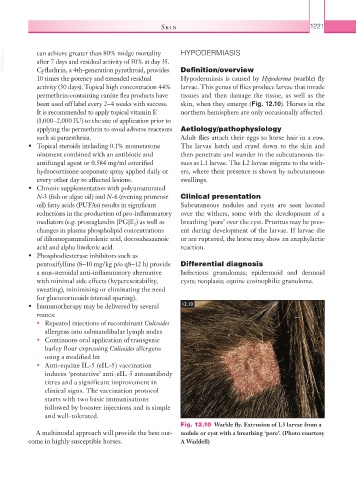Page 1246 - Equine Clinical Medicine, Surgery and Reproduction, 2nd Edition
P. 1246
Skin 1221
VetBooks.ir can achieve greater than 80% midge mortality HYPODERMIASIS
after 7 days and residual activity of 50% at day 35.
Cyfluthrin, a 4th-generation pyrethroid, provides
10 times the potency and extended residual Definition/overview
Hypodermiasis is caused by Hypoderma (warble) fly
activity (30 days). Topical high concentration 44% larvae. This genus of flies produce larvae that invade
permethrin-containing canine flea products have tissues and then damage the tissue, as well as the
been used off label every 2–4 weeks with success. skin, when they emerge (Fig. 12.10). Horses in the
It is recommended to apply topical vitamin E northern hemisphere are only occasionally affected.
(1,000–2,000 IU) to the site of application prior to
applying the permethrin to avoid adverse reactions Aetiology/pathophysiology
such as paraesthesia. Adult flies attach their eggs to horse hair in a row.
• Topical steroids including 0.1% mometasone The larvae hatch and crawl down to the skin and
ointment combined with an antibiotic and then penetrate and wander in the subcutaneous tis-
antifungal agent or 0.584 mg/ml esterified sues as L1 larvae. The L2 larvae migrate to the with-
hydrocortisone aceponate spray applied daily or ers, where their presence is shown by subcutaneous
every other day to affected lesions. swellings.
• Chronic supplementation with polyunsaturated
N-3 (fish or algae oil) and N-6 (evening primrose Clinical presentation
oil) fatty acids (PUFAs) results in significant Subcutaneous nodules and cysts are seen located
reductions in the production of pro-inflammatory over the withers, some with the development of a
mediators (e.g. prostaglandin [PG]E ) as well as breathing ‘pore’ over the cyst. Pruritus may be pres-
2
changes in plasma phospholipid concentrations ent during development of the larvae. If larvae die
of dihomogammalinolenic acid, docosahexaenoic or are ruptured, the horse may show an anaphylactic
acid and alpha linolenic acid. reaction.
• Phosphodiesterase inhibitors such as
pentoxifylline (8–10 mg/kg p/o q8–12 h) provide Differential diagnosis
a non-steroidal anti-inflammatory alternative Infectious granulomas; epidermoid and dermoid
with minimal side effects (hyperexcitability, cysts; neoplasia; equine eosinophilic granuloma.
sweating), minimising or eliminating the need
for glucocorticoids (steroid sparing).
• Immunotherapy may be delivered by several 12.10
routes:
• Repeated injections of recombinant Culicoides
allergens into submandibular lymph nodes
• Continuous oral application of transgenic
barley flour expressing Culicoides allergens
using a modified bit
• Anti-equine IL-5 (eIL-5) vaccination
induces ‘protective’ anti-eIL-5 autoantibody
titres and a significant improvement in
clinical signs. The vaccination protocol
starts with two basic immunisations
followed by booster injections and is simple
and well-tolerated.
Fig. 12.10 Warble fly. Extrusion of L3 larvae from a
A multimodal approach will provide the best out- nodule or cyst with a breathing ‘pore’. (Photo courtesy
come in highly susceptible horses. A Waddell)

